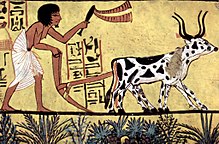綠色革命
外觀

 |
| 農業和農學 |
|---|
| 農業史 |
| 農業 |
| 其他類型 |
| 有關 |
| 分類 |
|
|
綠色革命(英語:Green Revolution),或稱為第三次農業革命(Third Agricultural Revolution),是一組1950年至1960年代末之間的一系列研究技術轉讓倡議,1960年代末開始最顯著地提高了全世界的農業產量,特別是在開發中國家。[1] 這些舉措使新技術得到應用,其中包括穀物的高產品種(HYVs),特別是矮化小麥和水稻、化肥和農用化學品結合、可控的供水(通常涉及灌溉)和新耕種方法,包括機械化。這些都被視為將取代「傳統」技術、被整體採用的「一攬子實踐」。[2]
福特基金會和洛克菲勒基金會都參與了綠色革命在墨西哥的最初發展。[3][4]其中一位主要領導人「綠色革命之父」諾曼·博勞格於1970年獲得諾貝爾和平獎。他因拯救了超過十億的飢餓人口而倍受讚譽。其基本方法是開發穀物高產品種,擴大灌溉基礎設施,現代化管理技術,向農民分發雜交種子、合成肥料和農藥。
美國國際開發署(USAID)署長威廉·高德(William S. Gaud)在1968年3月8日的演講中首次使用了「綠色革命」一詞,他提到了新技術的傳播:「農業領域中這些及其他的進步包含著一場新的革命。這不是像蘇聯那樣的紅色革命,也不是像伊朗國王那樣的白色革命。我稱之為綠色革命。」[5][6]
參見
[編輯]參考文獻
[編輯]引用
[編輯]- ^ Hazell, Peter B.R. The Asian Green Revolution. IFPRI Discussion Paper (Intl Food Policy Res Inst). 2009 [2019-12-24]. GGKEY:HS2UT4LADZD. (原始內容存檔於2020-10-28).
- ^ Farmer, B. H. Perspectives on the 'Green Revolution'in South Asia. Modern Asian Studies. 1986, 20 (1): 175–99. doi:10.1017/s0026749x00013627.
- ^ Wright, Angus, "Downslope and North: How Soil Degradation and Synthetic Pesticides Drove the Trajectory of Mexican Agriculture through the Twentieth Century" in Christopher R. Boyer, A Land Between Waters: Environmental Histories of Modern Mexico. Tucson: University of Arizona Press 2012, pp. 22-49.
- ^ Gary Toenniessen et al. "Building an alliance for a green revolution in Africa." Annals of the New York academy of sciences 1136.1 (2008): 233–42. online (頁面存檔備份,存於網際網路檔案館)
- ^ Gaud, William S. The Green Revolution: Accomplishments and Apprehensions. AgBioWorld. 8 March 1968 [8 August 2011]. (原始內容存檔於2016-01-18).
- ^ Marie-Monique Robin, The World According to Monsanto: Pollution, Corruption, and the Control of the World's Food Supply (The New Press, 2010) p. 308 [缺少ISBN]
資料來源
[編輯]- Dr Arvind Upadhayaya. Black spots in Green revolution. [2019-12-24]. (原始內容存檔於2021-02-24).
- Conway, Gordon. The doubly green revolution: food for all in the twenty-first century. Ithaca, NY: Comstock Pub. 1998. ISBN 978-0-8014-8610-4.
- Dowie, Mark. American foundations: an investigative history. Cambridge, MA: MIT. 2001. ISBN 978-0-262-04189-8.
- Farrell, John Joseph; Altieri, Miguel A. Agroecology: the science of sustainable agriculture 2nd. Boulder, CO: Westview. 1995. ISBN 978-0-8133-1718-2.
- Frison, Emile. Green Revolution in Africa will depend on biodiversity. Development and Cooperation. 2008, 49 (5): 190–93. (原始內容存檔於8 December 2008).
- Jain, H.K. The Green Revolution: History, Impact and Future 1st. Houston, TX: Studium Press. 2010. ISBN 978-1-933699-63-9.
- Oasa, Edmund K. Glaeser, Bernhard , 編. The Green Revolution revisited: critique and alternatives. Allen & Unwin. 1987: 13–55. ISBN 978-0-04-630014-2.
- Ross, Eric. The Malthus Factor: Poverty, Politics and Population in Capitalist Development. London: Zed Books. 1998. ISBN 978-1-85649-564-6.
- Ruttan, Vernon. The Green Revolution: Seven Generalizations. International Development Review. 1977, 19: 16–23.
- Sen, Amartya Kumar; Drèze, Jean. Hunger and public action. Oxford: Clarendon Press. 1989. ISBN 978-0-19-828365-2.
- Shiva, Vandana. The violence of the green revolution: Ecological degradation and political conflict in Punjab. Dehra Dun: Research Foundation for Science and Ecology. 1989. ISBN 978-81-85019-19-2.
- Smil, Vaclav. Enriching the Earth: Fritz Haber, Carl Bosch, and the Transformation of World Food Production. MIT Press. 2004. ISBN 978-0-262-69313-4.
- Spitz, Pierre. Glaeser, Bernhard , 編. The Green Revolution revisited: critique and alternatives. Allen & Unwin. 1987: 57–75. ISBN 978-0-04-630014-2.
- Wright, Angus. Bruce Colman; Jackson, Wes , 編. Meeting the expectations of the land: essays in sustainable agriculture and stewardship. San Francisco: North Point Press. 1984: 124–38. ISBN 978-0-86547-171-9. Editors list列表缺少
|last2=(幫助) - Wright, Angus Lindsay. The death of Ramón González: the modern agricultural dilemma. Austin: University of Texas Press. 2005. ISBN 978-0-292-71268-3.
延伸閱讀
[編輯]- Cotter, Joseph (2003). Troubled Harvest: Agronomy and Revolution in Mexico, 1880–2002. Westport, CT: Prager [缺少ISBN]
- Deb, Debal, "Restoring Rice Biodiversity", Scientific American, vol. 321, no. 4 (October 2019), pp. 54–61. "India originally possessed some 110,000 landraces of rice with diverse and valuable properties. These include enrichment in vital nutrients and the ability to withstand flood, drought, salinity or pest infestations. The Green Revolution covered fields with a few high-yielding varieties, so that roughly 90 percent of the landraces vanished from farmers' collections. High-yielding varieties require expensive inputs. They perform abysmally on marginal farms or in adverse environmental conditions, forcing poor farmers into debt." (p. 54.)
- Harwood, Andrew (14 June 2013). "Development policy and history: lessons from the Green Revolution" (頁面存檔備份,存於網際網路檔案館).
- Jain, H.K. Green revolution: history, impact and future. Houston: Studium Press. 2010. ISBN 978-1441674487. A brief history, for general readers.
外部連結
[編輯]- Norman Borlaug talk transcript, 1996
- The Green Revolution in the Punjab, by Vandana Shiva (頁面存檔備份,存於網際網路檔案館)
- Accelerating the Green Revolution in Africa. Rockefeller Foundation. (原始內容存檔於2 October 2010).
- Moseley, W. G. In search of a better revolution. Minneapolis StarTribune. 14 May 2008. (原始內容存檔於16 December 2018).
- Rowlatt, Justin. IR8: The Miracle Rice Which Saved Millions of Lives. BBC News. December 1, 2016 [December 1, 2016]. (原始內容存檔於2021-04-25). About the 50th anniversary of the rice strain.


